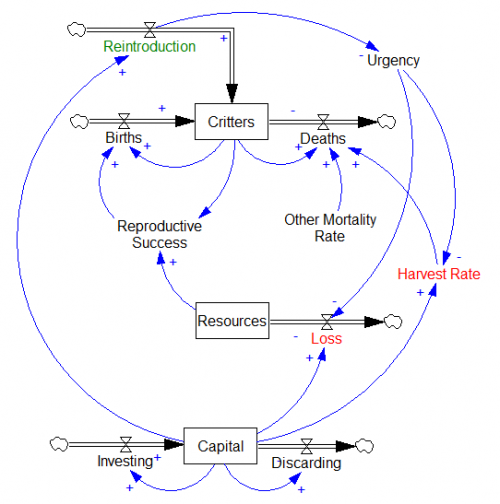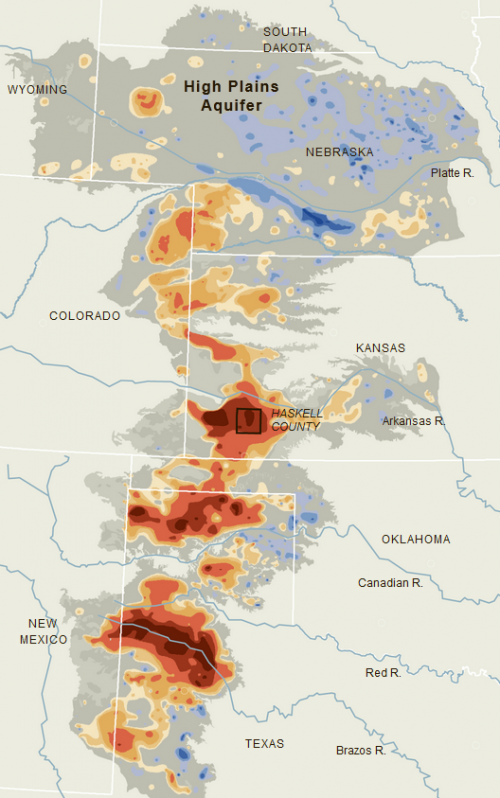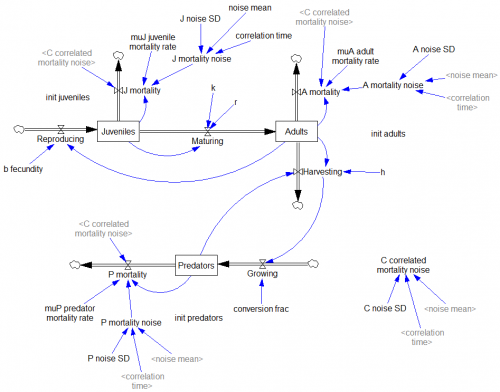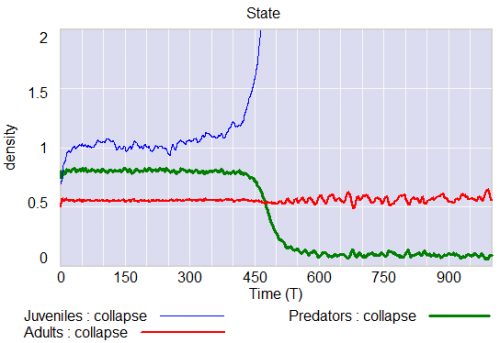I’m preparing for a talk on the dynamics of dictatorship or authoritarianism, which touches on many other topics, like polarization, conflict, terror and insurgency, and filter bubbles. I thought I’d share a few references, in the hope of attracting more. I’m primarily interested in mathematical models, or at least conceptual models that have clearly-articulated structure->behavior relationships. Continue reading “Dynamics of Dictatorship”
Category: Sustainability
Species Restoration & Policy Resistance
I’ve seen a lot of attention lately to restoration of extinct species. It strikes me as a band-aid, not a solution.
Here’s the core of the system:
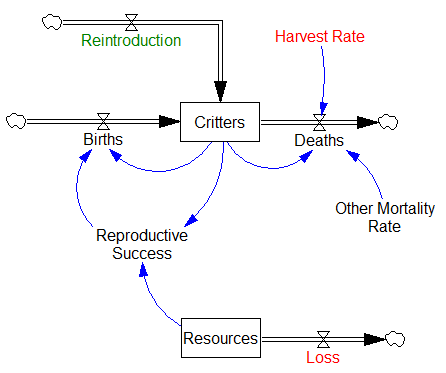 Critters don’t go extinct for lack of human intervention. They go extinct because the balance of birth and death rates is unfavorable, so that population declines, and (stochastically) winks out.
Critters don’t go extinct for lack of human intervention. They go extinct because the balance of birth and death rates is unfavorable, so that population declines, and (stochastically) winks out.
That happens naturally of course, but anthropogenic extinctions are happening much faster than usual. The drivers (red) are direct harvest and loss of the resource base on which species rely. The resource base is largely habitat, but also other species and ecosystem services that are themselves harvested, poisoned by pollutants, etc.
Reintroducing lost species may be helpful in itself (who wouldn’t want to see millions of passenger pigeons?), but unless the basic drivers of overharvest and resource loss are addressed, species are reintroduced into an environment in which the net gain of births and deaths favors re-extinction. What’s the point of that?
If the drivers of extinction – ultimately population and capital growth plus bad management – were under control, we wouldn’t need much restoration. If they’re out of control, genetic restoration seems likely to be overwhelmed, or perhaps even to contribute to problems through parachuting cats side effects.
Depleting fossil water
The NYT has an interesting article on the decline of the High Plains aquifer, which includes the famous Ogallala aquifer. Water tables are dramatically down (red) in many areas, making irrigation impractical.
Vast stretches of Texas farmland lying over the aquifer no longer support irrigation. In west-central Kansas, up to a fifth of the irrigated farmland along a 100-mile swath of the aquifer has already gone dry. In many other places, there no longer is enough water to supply farmers’ peak needs during Kansas’ scorching summers.
And when the groundwater runs out, it is gone for good. Refilling the aquifer would require hundreds, if not thousands, of years of rains.
This is a widespread, generic problem, and instance of the tragedy of the commons archetype:
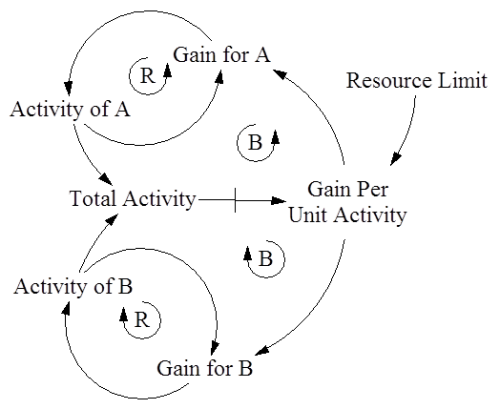
Alternately, as an economist might put it, depletion of groundwater is typically an externality, with zero rent paid from users to owners (us).
There are three facets to management of the problem: the commons problem, detail complexity from the complex geology of aquifers, and dynamic complexity. Allocation of property rights solves the commons problem, but not the others (see Erling Moxnes’ interesting work on this).
Sniffing around for material for this post, I found it easy to get lots of complicated information about aquifers, but hard to find any simple stock-flow pictures that revealed their state or dynamics, like this:
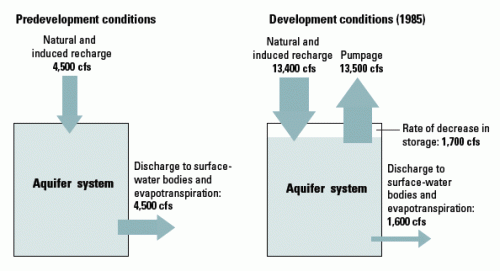
Source: USGS
This suggests that there’s some low-hanging fruit to be harvested through provision of simple feedback, as in the Climate Scoreboard.
Early warnings of catastrophe
There are warning signs when the active structure of a system is changing. But a new paper shows that they may not always be helpful for averting surprise catastrophes.
Catastrophic Collapse Can Occur without Early Warning: Examples of Silent Catastrophes in Structured Ecological Models (PLOS ONE – open access)
Catastrophic and sudden collapses of ecosystems are sometimes preceded by early warning signals that potentially could be used to predict and prevent a forthcoming catastrophe. Universality of these early warning signals has been proposed, but no formal proof has been provided. Here, we show that in relatively simple ecological models the most commonly used early warning signals for a catastrophic collapse can be silent. We underpin the mathematical reason for this phenomenon, which involves the direction of the eigenvectors of the system. Our results demonstrate that claims on the universality of early warning signals are not correct, and that catastrophic collapses can occur without prior warning. In order to correctly predict a collapse and determine whether early warning signals precede the collapse, detailed knowledge of the mathematical structure of the approaching bifurcation is necessary. Unfortunately, such knowledge is often only obtained after the collapse has already occurred.
To get the insight, it helps to back up a bit. (If you haven’t read my posts on bifurcations and 1D vector fields, they’re good background for this.)
Consider a first order system, with a flow that is a sinusoid, plus noise:
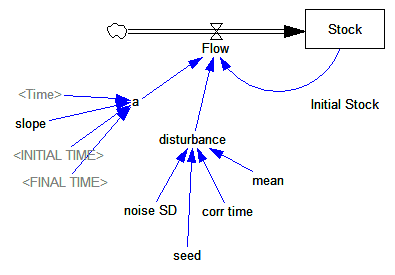
Flow=a*SIN(Stock*2*pi) + disturbance
For different values of a, and disturbance = 0, this looks like:
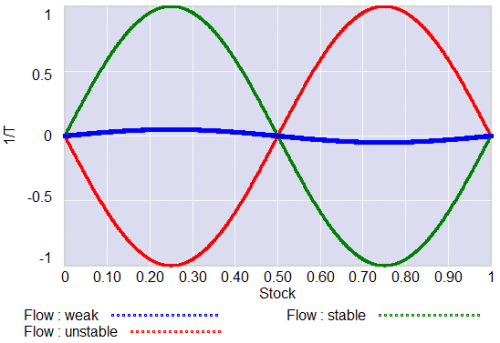 For a = 1, the system has a stable point at stock=0.5. The gain of the negative feedback that maintains the stable point at 0.5, given by the slope of the stock-flow phase plot, is strong, so the stock will quickly return to 0.5 if disturbed.
For a = 1, the system has a stable point at stock=0.5. The gain of the negative feedback that maintains the stable point at 0.5, given by the slope of the stock-flow phase plot, is strong, so the stock will quickly return to 0.5 if disturbed.
For a = -1, the system is unstable at 0.5, which has become a tipping point. It’s stable at the extremes where the stock is 0 or 1. If the stock starts at 0.5, the slightest disturbance triggers feedback to carry it to 0 or 1.
For a = 0.04, the system is approaching the transition (i.e. bifurcation) between stable and unstable behavior around 0.5. The gain of the negative feedback that maintains the stable point at 0.5, given by the slope of the stock-flow phase plot, is weak. If something disturbs the system away from 0.5, it will be slow to recover. The effective time constant of the system around 0.5, which is inversely proportional to a, becomes long for small a. This is termed critical slowing down.
For a=0 exactly, not shown, there is no feedback and the system is a pure random walk that integrates the disturbance.
The neat thing about critical slowing down, or more generally the approach of a bifurcation, is that it leaves fingerprints. Here’s a run of the system above, with a=1 (stable) initially, and ramping to a=-.33 (tipping) finally. It crosses a=0 (the bifurcation) at T=75. The disturbance is mild pink noise.
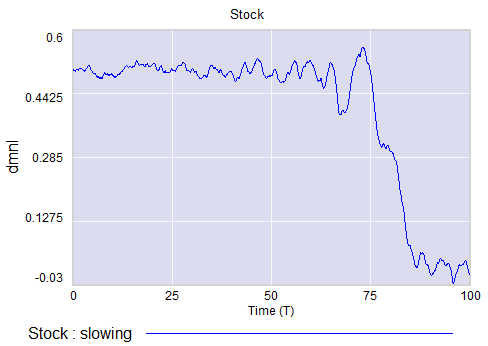
Notice that, as a approaches zero, particularly between T=50 and T=75, the variance of the stock increases considerably.
This means that you can potentially detect approaching bifurcations in time series without modeling the detailed interactions in the system, by observing the variance or similar, better other signs. Such analyses indicate that there has been a qualitative change in Arctic sea ice behavior, for example.
Now, back to the original paper.
It turns out that there’s a catch. Not all systems are neatly one dimensional (though they operate on low-dimensional manifolds surprisingly often).
In a multidimensional phase space, the symptoms of critical slowing down don’t necessarily reveal themselves in all variables. They have a preferred orientation in the phase space, associated with the eigenvectors of the eigenvalue that’s changing at the bifurcation.
The authors explore a third-order ecological model with juvenile and adult prey and a predator:
Predators undergo a collapse when their mortality rate exceeds a critical value (.553). Here, I vary the mortality rate gradually from .55 to .56, with the collapse occurring around time 450:
Note that the critical value of the mortality rate is actually passed around time 300, so it takes a while for the transient collapse to occur. Also notice that the variance of the adult population changes a lot post-collapse. This is another symptom of qualitative change in the dynamics.
The authors show that, in this system, approaching criticality of the predator mortality rate only reveals itself in increased variance or autocorrelation if noise impacts the juvenile population, and even then you have to be able to see the juvenile population.
We have shown three examples where catastrophic collapse can occur without prior early warning signals in autocorrelation or variance. Although critical slowing down is a universal property of fold bifurcations, this does not mean that the increased sensitivity will necessarily manifest itself in the system variables. Instead, whether the population numbers will display early warning will depend on the direction of the dominant eigenvector of the system, that is, the direction in which the system is destabilizing. This theoretical point also applies to other proposed early warning signals, such as skewness [18], spatial correlation [19], and conditional heteroscedasticity [20]. In our main example, early warning signal only occurs in the juvenile population, which in fact could easily be overlooked in ecological systems (e.g. exploited, marine fish stocks), as often only densities of older, more mature individuals are monitored. Furthermore, the early warning signals can in some cases be completely absent, depending on the direction of the perturbations to the system.
They then detail some additional reasons for lack of warning in similar systems.
In conclusion, we propose to reject the currently popular hypothesis that catastrophic shifts are preceded by universal early warning signals. We have provided counterexamples of silent catastrophes, and we have pointed out the underlying mathematical reason for the absence of early warning signals. In order to assess whether specific early warning signals will occur in a particular system, detailed knowledge of the underlying mathematical structure is necessary.
In other words, critical slowing down is a convenient, generic sign of impending change in a time series, but its absence is not a reliable indicator that all is well. Without some knowledge of the system in question, surprise can easily occur.
I think one could further strengthen the argument against early warning by looking at transients. In my simulation above, I’d argue that it takes at least 100 time units to detect a change in the variance of the juvenile population with any confidence, after it passes the critical point around T=300 (longer, if someone’s job depends on not seeing the change). The period of oscillations of the adult population in response to a disturbance is about 20 time units. So it seems likely that early warning, even where it exists, can only be established on time scales that are long with respect to the natural time scale of the system and environmental changes that affect it. Therefore, while signs of critical slowing down might exist in principle, they’re not particularly useful in this setting.
Catastrophic Collapse Can Occur without Early Warning: Examples of Silent Catastrophes in Structured Ecological Models
Fight or flight in resource modeling
A nice reflection on modeling in emotionally charged situations, from Drew Jones, Don Seville & Donella Meadows, Resource Sustainability in Commodity Systems: The Sawmill Industry in the Northern Forest:
Through the workshops and discussions about the forest economy, we also learned that even raising questions of growth and limits can trigger strong defensive routines …, both at the individual level and the organizational level, that make it difficult even to remain engaged in thinking about ecological limits and, therefore, taking any action. Managing these complex process challenges effectively was essential to using systems modeling to help people move towards well-reasoned action or inaction.
… We were presenting our base run to a group of mill executives and landowners from five different companies. During the walk-through of the base-run behavior of mill capacity (which begins to contract severely several decades in the future) we found that a few participants quickly dismissed that possibility, saying, ‘‘Sawmill capacity in this region will never shrink like that,’’ and aggressively pressing us on what factors we had included so that (we presume) they could uncover something missing or incorrect and dismiss the findings. Their body language and tone of voice led us to believe the participants were angry and emotionally charged.
… we came to identify a recurring set of defensive routines, that is, both emotionally laden reflexive responses to seeing the graphs of overshoot in which participants did not connect their critique to an underlying structural theory, or simply disengaged from thinking about the questions at hand. … When we encountered these reactions, we found ourselves torn between avoiding the conflict (the ‘‘flight’’ reaction; modifying our story to fit within their pre-existing assumptions, de-emphasizing the behavior of the model and switching to interview mode, talking about the systems methodology rather than implications of this particular model) or by pushing harder on our own viewpoint (the ‘‘fight’’ reaction; explaining why our assumptions are right, defending the logic behind our model). Neither of these responses was effective.
Back to the presentation to the industry group. During a break, after we had just survived the morning’s tensions and had struggled to avoid ‘‘fight or flight,’’ Dana [Meadows] walked up to us, smiling, and said, ‘‘Isn’t this going great?’’ ‘‘What?!?,’’ we thought.
‘‘The main purpose of our modeling,’’ she said ‘‘is to bring people to this moment—the moment of discomfort, of cognitive dissonance, where they can begin to see how current ways of thinking and their deeply held beliefs are not working anymore, how they are creating a future that they don’t want. The key as a modeler who triggers denial or apathy is to bring the group to this moment, and then just breathe. Hold us there for as long as possible. Don’t fight back. Don’t qualify your conclusions about what structures create what behaviors. State them clearly, and then just hold on.’’
Sharing Systems
I’m at the 30th Balaton Group meeting this week. A group of us just put our heads together to think about online approaches to teaching and sharing systems thinking and systems modeling. The basic question was, if you needed thousands of systems thinkers in a hurry, how could you scale up systems education quickly?
My list of interesting things people might want to do online:
- Model building
- Group model building (in the spirit of SUNY Albany work)
- Collaborative modeling (e.g., a distributed team working on federated modules of a model, but not necessarily involving the client and group conceptualization processes)
- Collaborative causal loop diagramming
- Model code sharing and reuse
- Model consumption
- Online games (playing through a simulation in real time) – possibly multiplayer
- Online simulations (interactive experimentation with a model) – possibly with a social aspect as at Climate Colab
Much can already be done through online model services like Forio and other means. However, I think there’s a lot more to be done. In particular, we’re weak on providing shared model transparency and quality control for any but the simplest models.
Some interesting systems & sustainability online learning links that came up in the conversation:
http://www.unep.org/ieacp/iea/
http://www.google.com/tools/dlpage/res/talkvideo/hangouts/
http://www.watersfoundation.org/
http://www.systemdynamics.org/MITCollectionRoadMaps.htm
Is London a big whale?
Why do cities survive atom bombs, while companies routinely go belly up?
Geoffrey West on The Surprising Math of Cities and Corporations:
There’s another interesting video with West in the conversations at Edge.
West looks at the metabolism of cities, and observes scale-free behavior of good stuff (income, innovation, input efficiency) as well as bad stuff (crime, disease – products of entropy). The destiny of cities, like companies, is collapse, except to the extent that they can innovate at an accelerating rate. Better hope the Singularity is on schedule.
Thanks to whoever it was at the SD conference who pointed this out!
Why is the arctic brown?
I’m blogging from a 757, somewhere over the North pole, returning from a sustainability meeting in Iceland. The world below is a wilderness of sea ice and clouds. I’d expect brilliant white, but there’s actually a brown haze over the landscape. It’s stratified, much like the odd sight of half-white, half-brown clouds one occasionally sees when flying into a polluted city. Where does it come from? Chinese coal fumes? Russian fires? American SUV tailpipes? Icelandic airplane exhaust?
You are what you eat
I’m on my way home from the 29th meeting of the Balaton Group, held in Iceland. Iceland seems to be rising gracefully from it’s financial crisis, with introspection into the values that led to it and a renewed interest in sustainability. Author Andri Magnason visited us at dinner, and talked a bit about Iceland and his wonderful book, Dreamland – A Self-help Manual for a Frightened Nation. I picked up a copy in the airport (can’t get it at amazon yet) and got halfway through on the plane – I highly recommend it.
Another Magnason project is a book of Bonus Poetry, named for and spoofing the Icelandic Walmart.
You are what you eat
My grandfather was 70% water
He was 70% the stream
that trickled past his farm
he was the 30%
the sheep that grazed on his mountain
he was the fish swimming in his lake
he was the cow eating
in his field
he was the stream, he was the grass,
the mountain and the lake
I am not 70% water
perhaps 15% mineral water
the rest is beer and coca cola
I am italian pasta, swiss cheese
danish pork and chinese rice
american ketchup
runs through my veins
you are what you eat
I am a miniature of the world
no
I am a miniature of Bonus
Waiting for a miracle at Lake Mead
Lake Mead has dropped another ten feet since I wrote about its open-loop management,
My hypothesis is that the de facto policy for managing water levels is to wait for good years to restore the excess withdrawals of bad years, and that demand management measures in the interim are toothless. That worked back when river flows were not fully subscribed. The trouble is, supply isn’t stationary, and there’s no reason to assume that it will return to levels that prevailed in the early years of river compacts. At the same time, demand isn’t stationary either, as population growth in the west drives it up. To avoid Lake Mead drying up, the system is going to have to get a spine, i.e. there’s going to have to be some feedback between water availability and demand.
An article in the Arizona Republic confirms my thinking,
To slow the lake’s years-long decline, river users have built a reservoir west of Yuma to catch unused runoff, paid farmers to leave fields unplanted and are negotiating with Mexico to leave some of its allocation in Lake Mead while its farmers recover from an earthquake.
None of the steps will yield significant amounts of water, but together, they could keep Lake Mead from sinking below the drought triggers, buying time until a wet winter can replenish some of the water lost to drought.
“It’s time that we need,” said David Modeer, general manager of the Central Arizona Project, which moves water from the Colorado River to Phoenix and Tucson. “The reservoirs have shown they’re resilient. After a 12-year drought, they’re still half-full. What we do now will be worth it to stay out of a shortage.”
Managers are assuming that a return to historic rainfall patterns will save their bacon. But if climate models are right, and the Southwest will be on the losing end of trends in precipitation, that won’t happen. Even if they’re wrong, increasing demand can easily overwhelm restored rainfall. At some point, the loop will have to close – the question is how. Will property rights get reallocated and price signals aligned so that people live within the limits of supply? Or will the lake wind up permanently depleted? There are some signs of improved cooperation among states, but Nevada appears to be betting on failure:
if the reservoir fell below elevation 1,050 feet, one of the tunnels Nevada uses to draw water from the lake would sit above the waterline and would be useless. Nevada is working on a new, deeper tunnel

